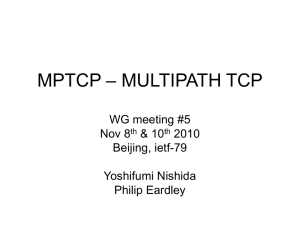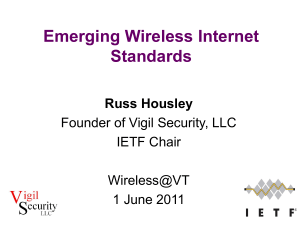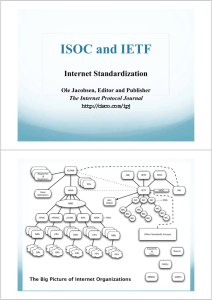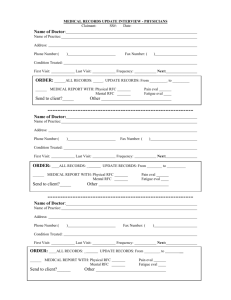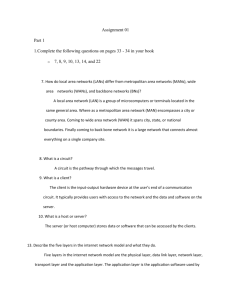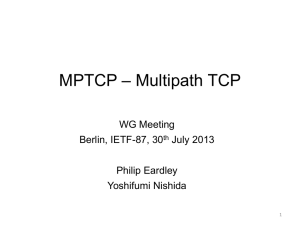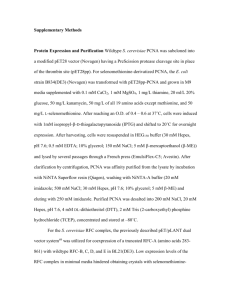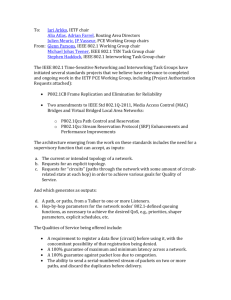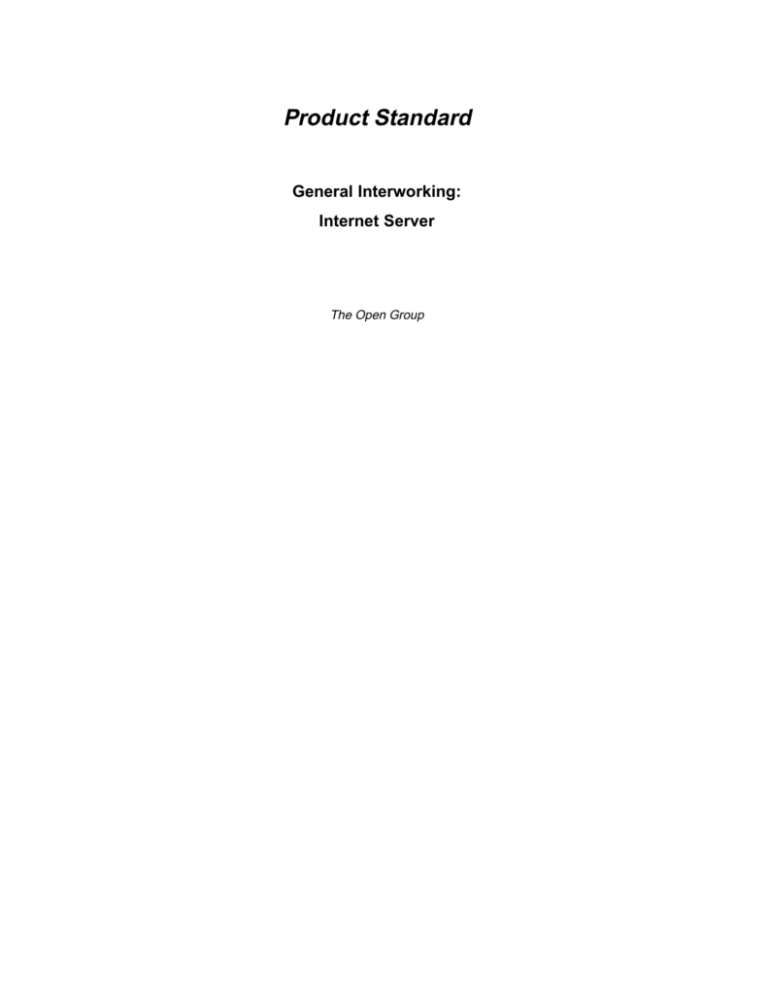
Product Standard
General Interworking:
Internet Server
The Open Group
Copyright August 1998, The Open Group
All rights reserved.
No part of this publication may be reproduced, stored in a retrieval system, or transmitted, in any form or
by any means, electronic, mechanical, photocopying, recording or otherwise, without the prior permission
of the copyright owners.
TM
Motif , OSF/1 , UNIX , and the ‘‘X Device’’ are registered trademarks and IT DialTone and The
TM
Open Group are trademarks of The Open Group in the U.S. and other countries.
TM
TM
Java , NFS , and WebNFS
TM
are trademarks of Sun Microsystems Inc.
Product Standard
General Interworking: Internet Server
Document Number: X98PS
Published in the U.K. by The Open Group, August 1998.
Any comments relating to the material contained in this document may be submitted to:
The Open Group
Apex Plaza
Forbury Road
Reading
Berkshire RG1 1AX
U.K.
Or by email to:
OGSpecs@opengroup.org
2
Product Standard
____________________________________________________
Product Standard
____________________________________________________
NAME
Internet Server
LABEL FOR LOGO
Internet Server
DESCRIPTION
This Product Standard defines a set of services in support of Internet and intranet technologies.
This includes support of network computer devices and the presence of a mandatory Java
Runtime Environment.
The Internet Server Product Standard complements the Network Computer1 providing the server
side of that definition. The emphasis is towards services and applications support. A standard
server will provide a set of core services to support Internet applications.
The mandatory functionality includes:
•
The Internet Protocol Suite
•
Java Runtime Environment
•
Internet capabilities to support network computer clients
CONFORMANCE REQUIREMENTS
Human-Computer Interface
Not applicable.
Portability Interface
•
Java Support
A conforming system provides a set of services that permit the execution of pre-compiled
applications that use the Java Runtime Environment (JRE) 1.1. This environment consists of
two parts:
— Java Virtual Machine (see Java Virtual Machine Specification Version 1.0.2)
__________________
1. Technical Standard, February 1998, Network Computer (C720).
General Interworking: Internet Server
3
Product Standard
— Java 1.1 Class Libraries (see Java Platform Core API)
Programming Language Environment
Not applicable.
Interoperability
•
TCP/IP Communications Service Interface
A conforming system provides a TCP/IP Communications Service interface, built on Internet
Standards.
— Internet Standard 3, Requirements for Internet Hosts: IETF RFC 1122, Requirements for
Internet Hosts — Communication Layers and IETF RFC 1123, Requirements for Internet
Hosts — Application and Support.
— Internet Standard 5, Internet Protocol, Version 4 (IPv4): IETF RFC 791, Internet Protocol,
IETF RFC 950, Internet Standard Subnetting Procedure, IETF RFC 919, Broadcasting
Internet Datagrams, IETF RFC 922, Broadcasting Internet Datagrams in the Presence of
Subnets, IETF RFC 792, Internet Control Message Protocol, and IETF RFC 1112, Host
Extensions for IP Multicasting.
— Internet Standard 6, User Datagram Protocol: IETF RFC 768, User Datagram Protocol.
— Internet Standard 7, Transmission Control:
Protocol.
•
IETF RFC 793, Transmission Control
SNMP Support
A conforming system provides support for the role of an SNMP agent.
— Internet Standard 15, A Simple Network Management
IETF RFC 1157, A Simple Network Management Protocol (SNMP).
Protocol
(SNMP):
— Internet Standard 16, Structure and Identification of Management Information for
TCP/IP-based Internets: IETF RFC 1155, Structure and Identification of Management
Information for TCP/IP-based Internets and IETF RFC 1212, Concise MIB Definitions
— Internet Standard 17, Management Information Base for Network Management of
TCP/IP-based Internets: IETF RFC 1213, Management Information Base for Network
Management of TCP/IP-based Internets.
The required MIBs to be provided on a managed system are those described in
IETF RFC 1213, Management Information Base for Network Management of TCP/IP-based
Internets
•
Hypertext Protocol Transfer Services
A conforming system provides a World Wide Web document server using the HTTP protocol.
It supports service of documents over both the HTTP protocol, or HTTP encapsulated within
the Secure Sockets Layer Protocol (SSL).
— IETF RFC 1738, Uniform Resource Locators (URL)
— IETF RFC 2068, Hypertext Transfer Protocol - HTTP/1.1
In addition, a conforming HTTP/1.1 server will:
— Recognize the format of the Request-Line for HTTP/1.0 (as defined in
IETF RFC 1945, Hypertext Transfer Protocol — HTTP/1.0) and HTTP/1.1 requests
4
Product Standard
Product Standard
— Understand any valid request in the format of HTTP/1.0 or HTTP/1.1
— Respond appropriately with a message in the same major version used by the client
— SSL, Secure Sockets Layer (SSL V3.0) Protocol, with support for X.509 certificates.
•
Internet Domain Name Service
A conforming system provides an Internet domain name server.
— Internet Standard 13, Domain Name System: IETF RFC 1034, Domain Names —
Concepts and Facilities and IETF RFC 1035, Domain Names — Implementation and
Specification.
— Support for IETF RFC 2136, Dynamic Updates in the Domain Name System (DNS
Update)
•
Terminal and File Services
A conforming system provides a telnet (virtual terminal) server, ftp (file transfer) server, and
an NFS file server. Optional file services include server support for WebNFS.
— Internet Standard 8, Telnet Protocol: IETF RFC 854, Telnet Protocol Specification and
IETF RFC 855, Telnet Option Specifications.
— Internet Standard 9, File Transfer Protocol: IETF RFC 959, File Transfer Protocol, with
the FTP commands Store Unique (STOU) and Abort (ABOR) mandated for reception.
— Remote filesystem support over Network File System, as specified in Protocols for
Interworking: XNFS, Version 3W.2
— Optional client and server support for file service using WebNFS, as specified in Protocols
for Interworking: XNFS, Version 3W, Appendix E, WebNFS Extensions. (IETF RFC 2054,
WebNFS Client Specification and IETF RFC 2055, WebNFS Server Specification.)
•
Mail Services
A conforming system provides Electronic Mail services. It will be able to act as an SMTP
server relay and be able to receive incoming messages. It will be able to act as a post office
supporting the POP3 protocol and IMAP4.
— Internet Standard 53, Post Office Protocol Version 3: IETF RFC 1939, Post Office
Protocol Version 3.
— Internet Standard 10, Simple Mail Transfer Protocol: IETF RFC 821, Simple Mail Transfer
Protocol and IETF RFC 1869, SMTP Service Extensions.
— Internet Standard 10, Simple Mail Transfer Protocol: IETF RFC 1870, SMTP Service
Extension for Message Size Declaration.
— Internet Standard 11, Format of Electronic Mail Messages: IETF RFC 822, Standard for
the Format of ARPA Internet Text Messages.
— Support for processing transmitted messages conforming to Internet Standard 11, Format
of Electronic Mail Messages: IETF RFC 1049, Content Type Header Field.
__________________
2. Technical Standard, February 1998, Protocols for Interworking: XNFS, Version 3W (ISBN: 1-85912-184-5, C702).
General Interworking: Internet Server
5
Product Standard
— Support for IETF RFC 2060, Internet Message Access Protocol Version 4rev1.
•
Print Services
A conforming system provides remote printing support.
— Remote printing support based on IETF RFC 1179, Line Printer Daemon Protocol. A
conforming system will document any differences from IETF RFC 1179, Line Printer
Daemon Protocol.
•
Client Booting Services
A conforming system provides client booting services using the bootp, tftp, and dhcp
protocols.
— IETF RFC 2131, Dynamic Host Configuration Protocol.
— IETF RFC 951, Bootstrap Protocol (BOOTP).
— Internet Standard 33, The TFTP Protocol (Revision 2): IETF RFC 1350, The Trivial File
Transfer Protocol (TFTP) (Revision 2).
•
Time Services
A conforming system provides Network Time Service (NTP).
— Internet Standard 12, Network Time Protocol (Version 2) Specification and
Implementation: IETF RFC 1119, Network Time Protocol (Version 2) Specification and
Implementation.
•
Directory Service
A conforming system provides LDAP server side, directory services.
— IETF RFC 1777, Lightweight Directory Access Protocol and IETF RFC 1778, The String
Representation of Standard Attribute Syntaxes.
— Optional support for LDAP 3 referrals (IETF RFC DRAFTS FOR LDAP 3, Draft IETF
ASID Standards for LDAP V3).
OPERATIONAL ENVIRONMENT
None.
PORTABILITY ENVIRONMENT
None.
OVERRIDING STANDARDS
All formal standards included within this Product Standard are specified by a direct reference to
the formal standard document itself.
6
Product Standard
Product Standard
INDICATORS OF COMPLIANCE
For the Network File System the Indicator of Compliance is a Test Report from a currently
authorized release of the VSX+XNFS Test Suite.
For the other constituent parts of this Product Standard there will be no initial Indicator of
Compliance specified. The Open Group intends to introduce tests of application-level
interoperability for protocols within this Product Standard (http, ftp, telnet, smtp, and so on).
Such tests will become a mandatory Indicator of Compliance three months after formal approval
for branding. Reference should be made to Test Suites and Test Laboratories to ascertain
whether the suite is now available, and whether the three month period has elapsed.
MIGRATION
The Internet services introduced are based on de facto practice and no migration issues are
anticipated.
General Interworking: Internet Server
7
Product Standard
8
Product Standard

